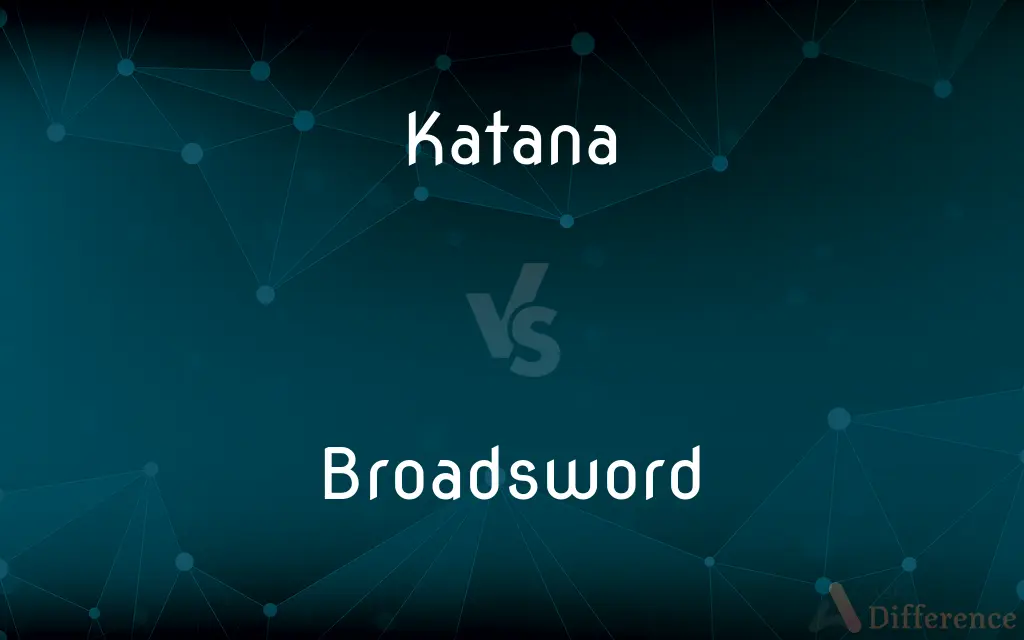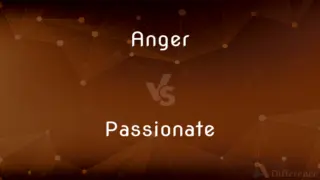Katana vs. Broadsword — What's the Difference?
By Maham Liaqat & Urooj Arif — Updated on April 25, 2024
A katana features a curved, slender blade optimized for slicing, while a broadsword sports a wider, straight double-edged blade designed for hacking and thrusting.

Difference Between Katana and Broadsword
Table of Contents
ADVERTISEMENT
Key Differences
The katana is a traditional Japanese sword with a curved, single-edged blade, circular or squared guard, and long grip to accommodate two hands. On the other hand, the broadsword, often associated with medieval Europe, features a straight, double-edged blade and is typically used with one hand.
While the katana is renowned for its sharpness and ability to execute precise cuts, the broadsword is valued for its versatility in slashing and thrusting moves. Both swords require significant skill, but the katana emphasizes technique and precision.
Historically, the katana was used by samurai in feudal Japan and was both a weapon and a symbol of social status. Whereas, the broadsword was commonly wielded by knights and soldiers in Europe, often symbolizing power and chivalry.
The crafting process of a katana involves a unique folding technique, which ensures strength and a razor-sharp edge. In contrast, broadswords were typically made from robust iron or steel, designed to withstand powerful impacts.
In popular culture, the katana is often depicted as a symbol of the skilled warrior, appearing in many films and books. Meanwhile, the broadsword is frequently associated with the heroic figures of Western folklore and fantasy genres.
ADVERTISEMENT
Comparison Chart
Origin
Japan
Europe
Blade Shape
Curved, single-edged
Straight, double-edged
Usage
Cutting, slicing
Slashing, thrusting
Historical Users
Samurai
Knights, soldiers
Cultural Symbol
Precision, technique
Power, chivalry
Compare with Definitions
Katana
Known for its distinctive appearance and sharp edge.
The katana's blade gleamed under the dim light of the dojo.
Broadsword
Designed for both cutting and thrusting.
His broadsword was versatile enough to slice through rope and armor alike.
Katana
A traditional Japanese sword with a curved, slender blade.
The samurai unsheathed his katana in a smooth, practiced motion.
Broadsword
Symbolizes strength and authority in Western cultures.
The king's broadsword lay in state, a symbol of his reign.
Katana
Symbolic in Japanese culture, representing the samurai’s honor and duty.
Each katana in the museum had a story tied to its samurai owner.
Broadsword
Often associated with medieval knights and warfare.
The museum displayed various broadswords from medieval times.
Katana
Often used in martial arts and ceremonial practices.
He performed a kata with his katana at the demonstration.
Broadsword
Commonly featured in Western historical and fantasy genres.
The characters in the novel fought with broadswords, reminiscent of medieval times.
Katana
Featured in many modern films and literature.
The hero wielded a katana, a nod to samurai influence.
Broadsword
A type of large, broad, double-edged sword used historically in Europe.
The knight brandished his broadsword, ready for battle.
Katana
A katana (刀 or かたな) is a Japanese sword characterized by a curved, single-edged blade with a circular or squared guard and long grip to accommodate two hands. Developed later than the tachi, it was used by samurai in feudal Japan and worn with the blade facing upward.
Broadsword
A sword with a wide blade, used for cutting rather than thrusting.
Katana
A long, single-edge sword for use with two hands, traditionally worn by samurai.
Broadsword
A sword with a wide, usually two-edged blade that is designed for slashing rather than thrusting.
Katana
A type of Japanese longsword or tr=nihontō, having a single edge and slight curvature, historically used by samurai and ninja.
Broadsword
(history) A type of early modern sword that has a broad double-edged blade for cutting (as opposed to the more slender thrust-oriented rapier) and typically a basket hilt.
Broadsword
A person armed with such a sword.
Broadsword
Syn of longsword
Broadsword
A flat, rectangular bread made from corn (maize) and beans by the Cherokee, traditionally by boiling rather than baking it.
Broadsword
A sword with a broad blade and a cutting edge; a claymore.
I heard the broadsword's deadly clang.
Broadsword
A sword with a broad blade and (usually) two cutting edges; used to cut rather than stab
Common Curiosities
How does a broadsword differ from a katana in blade design?
A broadsword has a wider, double-edged blade, while a katana features a curved, single-edged blade.
Which sword is heavier, a katana or a broadsword?
Typically, a broadsword is heavier than a katana, reflecting its design for powerful blows and armor penetration.
Can a katana be used with one hand?
Traditionally, a katana is used with two hands for optimal control and effectiveness.
How is a katana crafted differently from a broadsword?
A katana is crafted using a folding process that layers the steel, while a broadsword is typically forged from a single piece of metal.
What role does the broadsword play in modern culture?
In modern culture, the broadsword is often seen in fantasy films and books as a symbol of heroism and adventure.
What is the historical significance of a broadsword?
Broadswords have historical significance as weapons used by European knights for battle and ceremonial purposes.
Is there a cultural symbolism associated with katanas?
Yes, katanas symbolize the samurai's precision, honor, and duty in Japanese culture.
What is the primary use of a katana?
A katana is primarily used for slicing and precise cutting.
Who were the primary users of katanas in history?
Samurai in feudal Japan were the primary users of katanas.
What materials are used in the making of a broadsword?
Broadswords are typically made from steel or iron.
Share Your Discovery

Previous Comparison
Anger vs. Passionate
Next Comparison
Determination vs. FaithAuthor Spotlight
Written by
Maham LiaqatCo-written by
Urooj ArifUrooj is a skilled content writer at Ask Difference, known for her exceptional ability to simplify complex topics into engaging and informative content. With a passion for research and a flair for clear, concise writing, she consistently delivers articles that resonate with our diverse audience.















































